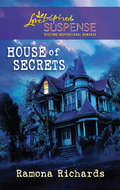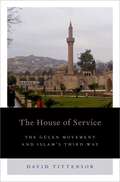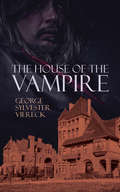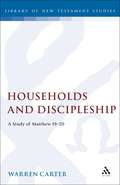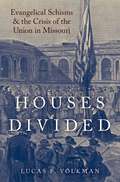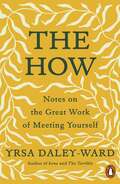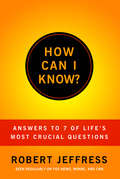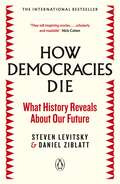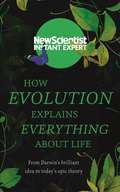- Table View
- List View
HOUSE OF SCIENCES C: The First Modern University in the Muslim World
by Ekmeleddin IhsanogluFollowing a string of military defeats at the end of the eighteenth century, Ottoman leaders realized that their classical traditions and institutions could not compete with Russia and the European states' technological and economic superiority.One of a series of nineteenth-century reform initiatives was the creation of a European-style university called darülfünun. From the Arabic words dar, meaning "house," and fünun, meaning "sciences," the darülfünun would incorporate the western sciences into deeply entrenched academic traditions and institutions in an effort to bridge the gap with Europe. The completely new institution, distinct from the existing pre-modern medreses, was modeled after the French educational system and created an infrastructure for national universities in Turkey and some of the Arab-speaking provinces. It also influenced the establishment of universities in Iran and Afghanistan. Ekmeleddin Ihsanoglu's study sheds new light on an important and pioneering experiment in East-West relations, tracking the multifaceted transformation at work in Istanbul during the transition from classical to modern modes of scientific education. Out of this intellectual ferment, a new Ottoman Turkish scientific language developed, the terminology of which served as a convenient vehicle for expressing and teaching modern science throughout the Empire.
House of Secrets (Mills And Boon Love Inspired Ser.)
by Ramona RichardsSheriff Ray Taylor always had a soft spot for the former minister's widow, June Eaton…
The House of Service: The Gulen Movement and Islam's Third Way (Religion and Global Politics)
by David TittensorDavid Tittensor offers a groundbreaking new perspective on the Gülen movement, a Turkish Muslim educational activist network that emerged in the 1960s and has grown into a global empire with an estimated worth of $25 billion. Named after its leader Fethullah Gülen, the movement has established more than 1,000 secular educational institutions in over 140 countries, aiming to provide holistic education that incorporates both spirituality and the secular sciences. Despite the movement's success, little is known about how its schools are run, or how Islam is operationalized. Drawing on thirteen months of ethnographic fieldwork in Turkey, Tittensor explores the movement's ideo-theology and how it is practiced in the schools. His interviews with both teachers and graduates from Africa, Indonesia, Central Asia, and Turkey show that the movement is a missionary organization, but of a singular kind: its goal is not simply widespread religious conversion, but a quest to recoup those Muslims who have apparently lost their way and to show non-Muslims that Muslims can embrace modernity and integrate into the wider community. Tittensor also examines the movement's operational side and shows how the schools represent an example of Mohammad Yunus's social business model: a business with a social cause at its heart. The House of Service is an insightful exploration of one of the world's largest transnational Muslim associations, and will be invaluable for those seeking to understand how Islam will be perceived and practiced in the future.
The House of the Mother: The Social Roles of Maternal Kin in Biblical Hebrew Narrative and Poetry (The Anchor Yale Bible Reference Library)
by Prof. Cynthia R. ChapmanA novel approach to Israelite kinship, arguing that maternal kinship bonds played key social, economic, and political roles for a son who aspired to inherit his father’s household Upending traditional scholarship on patrilineal genealogy, Cynthia Chapman draws on twenty years of research to uncover an underappreciated yet socially significant kinship unit in the Bible: “the house of the mother.” In households where a man had two or more wives, siblings born to the same mother worked to promote and protect one another’s interests. Revealing the hierarchies of the maternal houses and political divisions within the national house of Israel, this book provides us with a nuanced understanding of domestic and political life in ancient Israel.
The House of the Vampire
by George Sylvester Viereck"He felt the presence of the hand of Reginald Clark - unmistakably - groping in his brain as if searching for something that had still escaped him. He tried to move, to cry out, but his limbs were paralyzed. When, by a superhuman effort, he at last succeeded in shaking off the numbness that held him enchained, he awoke just in time to see a figure, that of a man, disappearing in the wall that separated Reginald's apartments from his room..."This vampire doesn't want the blood from your veins; he's after the ideas in your head. The hypnotic Reginald Clarke chooses his victims for their artistic abilities, charms them, and discards them after robbing them of their gifts. Originally published in 1907, this gothic novella was among the first stories of its type and remains a gripping tale of psychic vampirism.
The House of War: The Struggle between Christendom and the Caliphate
by Sir Simon MayallA powerful new history detailing the most significant military clashes between Islam and Christendom over the 1,300 years of the Muslim caliphate.From the taking of the holy city of Jerusalem in the 7th century AD by Caliph Umar, to the collapse of the Ottoman Empire following the end of World War I, Christian popes, emperors and kings, and Muslim caliphs and sultans were locked in a 1300-year battle for political, military, ideological, economic and religious supremacy. In this powerful new history of the era, acknowledged expert on the history of the Middle East and the Crusades Simon Mayall focuses on some of the most significant clashes of arms in human history: the taking and retaking of Jerusalem and the collapse of the Crusader states; the fall of Constantinople; the sieges of Rhodes and Malta; the assault on Vienna and the 'high-water mark' of Ottoman advance into Europe; culminating in the Allied capture of Jerusalem in World War I, the final collapse of the Ottoman Empire, the dissolution of the sultanate and the caliphate, and the formation of modern Europe and the modern Middle East. The House of War offers a wide, sweeping narrative, encompassing the broad historical and religious context of this period, while focussing on some of the key, pivotal sieges and battles, and on the protagonists, political and military, who determined their conclusions and their consequences.
The House of War: The Struggle between Christendom and the Caliphate
by Sir Simon MayallA powerful new history detailing the most significant military clashes between Islam and Christendom over the 1,300 years of the Muslim caliphate.From the taking of the holy city of Jerusalem in the 7th century AD by Caliph Umar, to the collapse of the Ottoman Empire following the end of World War I, Christian popes, emperors and kings, and Muslim caliphs and sultans were locked in a 1300-year battle for political, military, ideological, economic and religious supremacy. In this powerful new history of the era, acknowledged expert on the history of the Middle East and the Crusades Simon Mayall focuses on some of the most significant clashes of arms in human history: the taking and retaking of Jerusalem and the collapse of the Crusader states; the fall of Constantinople; the sieges of Rhodes and Malta; the assault on Vienna and the 'high-water mark' of Ottoman advance into Europe; culminating in the Allied capture of Jerusalem in World War I, the final collapse of the Ottoman Empire, the dissolution of the sultanate and the caliphate, and the formation of modern Europe and the modern Middle East. The House of War offers a wide, sweeping narrative, encompassing the broad historical and religious context of this period, while focussing on some of the key, pivotal sieges and battles, and on the protagonists, political and military, who determined their conclusions and their consequences.
House on Endless Waters: A Novel
by Emuna Elon'I read this book in excitement and wonder. It's not only a touching and fascinating book, but a sophisticated one as well.' Amos OzYoel has always known that his mother escaped the Nazis from Amsterdam. But it is not until after she has died that he finally visits the city of his birth. There, watching an old film clip at the Jewish Historical Museum, he sees a woman with a small child: it is his mother, but the child is not him. So begins a fervent search for the truth that becomes the subject of his magnum opus, revealing Amsterdam's dark wartime history and the underground networks which hid Jewish children away from danger - but at a cost.'[A] jewel box of a novel' - New York Times
Household Conversion Narratives in Acts: Pattern and Interpretation (The Library of New Testament Studies #123)
by David MatsonUsing features of the narrative-critical method, this book offers an innovative approach to a notable phenomenon in the book of Acts: the conversion of entire households to the Christian faith. When viewed against the household mission of the seventy(-two) messengers in Luke, the stories of Cornelius, Lydia, the Roman jailer and Crispus comprise a pattern of evangelistic activity that provides a common framework for their interpretation. Repetition and variation of the pattern offer important clues for the way each story functions within the wider context of Acts, opening up new lines of interpretation as well as new levels of unity/disunity between the Lukan writings.
Household Gods: The Religious Lives of the Adams Family
by Sara GeorginiReflecting on his past, President John Adams mused that it was religion that had shaped his family's fortunes and young America's future. For the nineteenth century's first family, the Adamses of Massachusetts, the history of how they lived religion was dynamic and well-documented. Christianity supplied the language that Abigail used to interpret husband John's political setbacks. Scripture armed their son John Quincy to act as father, statesman, and antislavery advocate. Unitarianism gave Abigail's Victorian grandson, Charles Francis, the religious confidence to persevere in political battles on the Civil War homefront. By contrast, his son Henry found religion hollow and repellent compared to the purity of modern science. A renewal of faith led Abigail's great-grandson Brooks, a Gilded Age critic of capitalism, to prophesy two world wars. Globetrotters who chronicled their religious journeys extensively, the Adamses ultimately developed a cosmopolitan Christianity that blended discovery and criticism, faith and doubt. Drawing from their rich archive, Sara Georgini, series editor for The Papers of John Adams, demonstrates how pivotal Christianity--as the different generations understood it--was in shaping the family's decisions, great and small. Spanning three centuries of faith from Puritan New England to the Jazz Age, Household Gods tells a new story of American religion, as the Adams family lived it.
Household Gods: The Religious Lives of the Adams Family
by Sara GeorginiReflecting on his past, President John Adams mused that it was religion that had shaped his family's fortunes and young America's future. For the nineteenth century's first family, the Adamses of Massachusetts, the history of how they lived religion was dynamic and well-documented. Christianity supplied the language that Abigail used to interpret husband John's political setbacks. Scripture armed their son John Quincy to act as father, statesman, and antislavery advocate. Unitarianism gave Abigail's Victorian grandson, Charles Francis, the religious confidence to persevere in political battles on the Civil War homefront. By contrast, his son Henry found religion hollow and repellent compared to the purity of modern science. A renewal of faith led Abigail's great-grandson Brooks, a Gilded Age critic of capitalism, to prophesy two world wars. Globetrotters who chronicled their religious journeys extensively, the Adamses ultimately developed a cosmopolitan Christianity that blended discovery and criticism, faith and doubt. Drawing from their rich archive, Sara Georgini, series editor for The Papers of John Adams, demonstrates how pivotal Christianity--as the different generations understood it--was in shaping the family's decisions, great and small. Spanning three centuries of faith from Puritan New England to the Jazz Age, Household Gods tells a new story of American religion, as the Adams family lived it.
Households and Discipleship: A Study of Matthew 19-20 (The Library of New Testament Studies #103)
by Warren CarterThis study addresses the question of whether a coherent sequence of pericopes can be identified in Matthew chapters 19-20. Employing audience-oriented criticism, it argues that the authorial audience's knowledge of the philosophical tradition concerning household structures provides that coherent sequence. But the audience also encounters in these chapters a critique of the household tradition's patriarchal and hierarchical structure of the rule of husband over wife, father over children, master over slaves, and the accumulation of wealth as an indicator of social identity. It understands that the community of disciples is to exhibit more egalitarian patterns. this alternative structure is placed in the context of wider socio-cultural forces which were also resisting aspects of the conventional household pattern. Features of the alternative structure - opposition ot hierarchical structures, a more egalitarian pattern, a temporal framework, marginal social location, minimalization of gender differences and authority roles and relationships, opposition to wealth - can be seen as aspects of an existence which Victor Turner identifies as normative or permanent liminality. that is, the study of chapters 19-20 contributes significantly to the formulation of the larger pattern of Matthean discipleship.
Houses Divided: Evangelical Schisms and the Crisis of the Union in Missouri (Religion in America)
by Lucas VolkmanHouses Divided provides new insights into the significance of the nineteenth-century evangelical schisms that arose initially over the moral question of African American bondage. Volkman examines such fractures in the Baptist, Methodist, and Presbyterian churches of the slaveholding border state of Missouri. He maintains that congregational and local denominational ruptures before, during, and after the Civil War were central to the crisis of the Union in that state from 1837 to 1876. The schisms were interlinked religious, legal, constitutional, and political developments rife with implications for the transformation of evangelicalism and the United States from the late 1830s to the end of Reconstruction. The evangelical disruptions in Missouri were grounded in divergent moral and political understandings of slavery, abolitionism, secession, and disloyalty. Publicly articulated by factional litigation over church property and a combative evangelical print culture, the schisms were complicated by the race, class, and gender dynamics that marked the contending interests of white middle-class women and men, rural church-goers, and African American congregants. These ruptures forged antagonistic northern and southern evangelical worldviews that increased antebellum sectarian strife and violence, energized the notorious guerilla conflict that gripped Missouri through the Civil War, and fueled post-war vigilantism between opponents and proponents of emancipation. The schisms produced the interrelated religious, legal and constitutional controversies that shaped pro-and anti-slavery evangelical contention before 1861, wartime Radical rule, and the rise and fall of Reconstruction.
Houses Divided: Evangelical Schisms and the Crisis of the Union in Missouri (Religion in America)
by Lucas VolkmanHouses Divided provides new insights into the significance of the nineteenth-century evangelical schisms that arose initially over the moral question of African American bondage. Volkman examines such fractures in the Baptist, Methodist, and Presbyterian churches of the slaveholding border state of Missouri. He maintains that congregational and local denominational ruptures before, during, and after the Civil War were central to the crisis of the Union in that state from 1837 to 1876. The schisms were interlinked religious, legal, constitutional, and political developments rife with implications for the transformation of evangelicalism and the United States from the late 1830s to the end of Reconstruction. The evangelical disruptions in Missouri were grounded in divergent moral and political understandings of slavery, abolitionism, secession, and disloyalty. Publicly articulated by factional litigation over church property and a combative evangelical print culture, the schisms were complicated by the race, class, and gender dynamics that marked the contending interests of white middle-class women and men, rural church-goers, and African American congregants. These ruptures forged antagonistic northern and southern evangelical worldviews that increased antebellum sectarian strife and violence, energized the notorious guerilla conflict that gripped Missouri through the Civil War, and fueled post-war vigilantism between opponents and proponents of emancipation. The schisms produced the interrelated religious, legal and constitutional controversies that shaped pro-and anti-slavery evangelical contention before 1861, wartime Radical rule, and the rise and fall of Reconstruction.
The How: Notes on the Great Work of Meeting Yourself
by Yrsa Daley-WardA treasure trove of inspiration and an invitation for personal renewal from the acclaimed author of bone and The TerribleWe still dream though, don't we? We are gifted with a way into ourselves, night after night after night.Yrsa Daley-Ward's words have resonated with hundreds of thousands of readers around the world: through her books of poetry and memoir bone and The Terrible, through her powerful writing for Beyoncé on Black Is King and through her always-illuminating Instagram posts.In The How, Yrsa gently takes readers by the hand, encouraging them to join her as she explores how we can remove our filters, and see and feel more of who we really are behind the preconceived notions of propriety and manners we've accumulated with age. With a mix of short, lyrical musings, immersive poetry and intriguing meditations, The How can be used to start conversations, to prompt writing, to delve deeper - whether you're on your own or with friends, on your feet or writing from the solace of home.'Lyrical . . . visceral truth is at the heart of her work' i Newspaper
How Are the Mighty Fallen?: A Dialogical Study of King Saul in 1 Samuel (The Library of Hebrew Bible/Old Testament Studies)
by Barbara GreenThis book marries the several elements: a given text (1 Samuel), a focal character (King Saul), a spacious and creative theorist (Mikhail Bakhtin), a historical context (the collapse of monarchic Israel and the moment for return. The dilemma for the exile community is to return with royal leadership or without it); a reading challenge is: can a character be a cipher for a corporate experience (Saul represent the whole monarchic experience)? The author argues that the narrative of 1 Samuel may be read as a riddle propounding the complex story of Israel/Judah's experience with kings as an instruction for those pondering leadership choices in the sixth century. The work is an extended reflection on what went wrong with kings and why new leadership must be attempted. The extended riddle of Saul works to show how the life of the king is fundamentally destructive, not because any is malicious but because of many factors of weakness and inadequacy that will be familiar to readers.
How Can I Know?: Answers to Life's 7 Most Important Questions
by Dr. Robert JeffressIf we are honest, every one of us has questions about our faith. We ask ourselves things like: "Is the Bible true?" "Why does God allow suffering?" "Am I truly forgiven?" "Will I really go to heaven when I die?" Dr. Robert Jeffress answers these and other challenging questions facing Christians today. Drawing upon the best research available, How Can I Know presents logical and concise responses that anyone can understand and easily share with others. In an age of information overload, simplicity is essential. Every chapter is filled with illustrations and application that will appeal to the average reader, giving them a renewed hope and reassurance of their faith.
How Can We Know What God Means: The Interpretation of Revelation
by J. GraciaIn spite of the growth of secularization, technology, and science, statistics tell us that religious conversions are on the rise, and the number of people who take religion and divine revelation seriously is at an all-time high. This phenomenon, curiously enough, has increased rather than decreased both inter and intra-religious conflicts: Protestants fight Catholics in Northern Ireland; Serbian Greek Orthodox fight with Kosovo Moslems in Yugoslavia; Jews fight with Moslems in Palestine; Hindus fight with Moslems in India - and the list is seemingly endless. There is bitter disagreement also in dealing with revelation, even within the same religious traditions and with regard to the same scriptures: Liberal Christians reject the literal interpretation of the Christian scriptures favored by Evangelicals; many Protestant groups do not accept the role of tradition in interpretation which Roman Catholics consider essential; Orthodox Jews strictly follow eating regulations presented in the Torah, but Reformed Jews take these in a different sense. The sources of these disagreements vary considerably. Some are rooted in historical events and traditions, but quite often they signal deep confusions concerning the interpretation of what believers take to be divinely revealed. In recent years, the author claims, the confusion has been compounded by the rise in the number and variety of interpretational approaches that are used to understand revelation. One can now take a culturalist, sociological, literary, psychoanalytical, historical, political, philosophical or feminist interpretations - to name just a few - approach. But do these all necessarily make sense when applied to religious texts? These and other questions cry out for answers which seldom are even attempted in the pertinent literature. This book offers a novel and sustained philosophical treatment of religious hermeneutics in which the author considers the main alternatives available in today's marketplace. The book is neither ideologically partisan nor thematically narrow and should be of interest to anyone concerned with interpreting the divine word. It offers a sensible roadmap to a topic that continues to draw heated debate in philosophy, theology, sociology, history and literary studies.
How Could I Ask for More: A Journey Of Heart Inspired By The #1 Song
by Cindy MorganInspired by the award winning song How Could I Ask for More, Cindy takes you on a journey in search of the answer why is enough never enough? How much more is more than enough? Her evocative writing about the people, places, and experiences that made her who she is will pierce your heart and challenge you to see the good things in your life as well as those things that threaten to keep you from the good things. Always honest, often funny, sometimes heartbreaking, Cindy Morgan transparently reflects on battles fought, blessings gleaned, and the beauty of a grace-filled life.
How Democracies Die: What History Reveals About Our Future
by Daniel Ziblatt Steven LevitskyTwo Harvard professors explain the dangerous world we face todayDemocracies can die with a coup d'état - or they can die slowly. This happens most deceptively when in piecemeal fashion, with the election of an authoritarian leader, the abuse of governmental power and the complete repression of opposition. All three steps are being taken around the world - not least with the election of Donald Trump - and we must all understand how we can stop them.In How Democracies Die, Harvard professors Steven Levitsky and Daniel Ziblatt draw insightful lessons from across history - from the rule of General Augusto Pinochet in Chile to the quiet undermining of Turkey's constitutional system by President Recip Erdogan - to shine a light on regime breakdown across the twentieth and twenty-first centuries. Notably they point to the dangers of an authoritarian leader faced with a major crisis. Based on years of research, they present a deep understanding of how and why democracies die; an alarming analysis of how democracy is being subverted today in the US and beyond; and a guide for maintaining and repairing a threatened democracy, for governments, political parties and individuals. History doesn't repeat itself. But we can protect our democracy by learning its lessons, before it's too late.
How Did It All Begin? (Brief Answers, Big Questions)
by Stephen Hawking'Remember to look up at the stars and not down at your feet'How did it all begin?Is there a God?Throughout his extraordinary career, Stephen Hawking expanded our understanding of the universe and unravelled some of its greatest mysteries. In How Did It All Begin? the world famous cosmologist and bestselling author of A Brief History of Time explores the fundamental questions of our existence.'A brilliant mind' Daily TelegraphBrief Answers, Big Questions: this stunning paperback series offers electrifying essays from one of the greatest minds of our age, taken from the original text of the No. 1 bestselling Brief Answers to the Big Questions.
How Do I Find the Christ?
by Rudolf Steiner"Once one has passed through powerlessness and refinds oneself, one also finds Christ. Before we can gain access to the Christ Impulse we must plumb the depths of our own feelings of insignificance, and this can only happen when we view our strengths and capacities without any pride."How does one find the Christ today? Rudolf Steiner emphasizes the importance of striving for self-knowledge, the significance of experiencing powerlessness, and the eventual resurrection from powerlessness. In this important lecture he also speaks about the ancient Academy of Gondishapur, the significance of the year 666, the mission of Islam, as well as the crucial consequences of the Ecumenical Council of 869.
How Do We Know?: Understanding in Science and Theology (Issues in Science and Theology)
by Dirk Evers Antje Jackelen Taede SmedesA study on the relationship between science and theology with respect to epistemological differences between religious belief and scientific knowledge.
How Evolution Explains Everything About Life: From Darwin’s brilliant idea to today’s epic theory (New Scientist Instant Expert)
by New ScientistHow did we get here? All cultures have a creation story, but a little over 150 years ago Charles Darwin introduced a revolutionary new one. We, and all living things, exist because of the action of evolution on the first simple life form and its descendants.We now know that it has taken 3.8 billions of years of work by the forces of evolution to turn what was once a lump of barren rock into the rich diversity of into plants, animals and microbes that surround us. In the process, evolution has created all manner of useful adaptions, from biological computers (brains) to a system to capture energy from the sun (photosynthesis). But how does evolution actually work? In Evolution, leading biologists and New Scientist take you on a journey of a lifetime, exploring the question of whether life is inevitable or a one-off fluke, and how it got kick-started. Does evolution have a purpose or direction? Are selfish genes really the driving force of evolution? And is evolution itself evolving?ABOUT THE SERIESNew Scientist Instant Expert books are definitive and accessible entry points to the most important subjects in science; subjects that challenge, attract debate, invite controversy and engage the most enquiring minds. Designed for curious readers who want to know how things work and why, the Instant Expert series explores the topics that really matter and their impact on individuals, society, and the planet, translating the scientific complexities around us into language that's open to everyone, and putting new ideas and discoveries into perspective and context.
How Fear Works: Culture of Fear in the Twenty-First Century
by Frank FurediIn 1997, Frank Furedi published a book called Culture of Fear. It was widely acclaimed as perceptive and prophetic. Now Furedi returns to his original theme, as most of what he predicted has come true. In How Fear Works, Furedi seeks to explain two interrelated themes: why has fear acquired such a morally commanding status in society today and how has the way we fear today changed from the way that it was experienced in the past? Furedi argues that one of the main drivers of the culture of fear is unravelling of moral authority. Fear appears to provide a provisional solution to moral uncertainty and is for that reason embraced by a variety of interests, parties and individuals. Furedi predicts that until society finds a more positive orientation towards uncertainty the politicisation of fear will flourish. Society is continually bombarded with the message that the threats it faces are incalculable and cannot be managed or contained. The ascendancy of this outlook has been paralleled by the cultivation of helplessness and passivity – all this has heightened people's sense of powerlessness and anxiety. As a consequence we are constantly searching for new forms of security, both physical and ontological. What are the drivers of fear, what is the role of the media in its promotion, and who actually benefits from this culture of fear? These are some of the issues Furedi tackles to explain the current predicament. He believes that through understanding how fear works, we can encourage attitudes that will help bring about a less fearful future.

